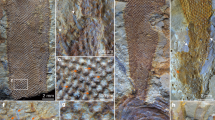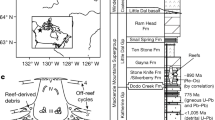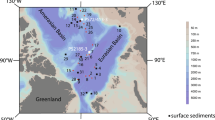Abstract
WE present here evidence that early Palaeozoic calcareous foraminifera existed and were relatively complex (multilocular and multiserial) in form but that they have been regarded formerly as calcareous algae. The early part of the invertebrate fossil record during the Cambrian period seems to show a striking contrast between the abundance of highly developed organisms such as the trilobite arthropods and the paucity of simpler forms such as the foraminiferal protozoans. Foraminifera are very small acellular animals with an important role in marine food chains1 and it is reasonable to expect them to have been a significant component of the benthic fauna throughout the Palaeozoic. Yet few foraminifera have been reported from the Lower Palaeozoic and those described from the Cambrian are mainly simple forms with unmineralised tectinous or agglutinated tests2–4. Some more complex agglutinated forms are known from the Upper Cambrian5, but the first generally recognised calcareous foraminifer is the uniserial Saccaminopsis from the late Ordovician4. Consequently, the assumptions that Lower Palaeozoic foraminifera were primitive and mainly non-calcareous have been taken as bases for inferences concerning the early evolution of the group3–4 and the paradoxical, yet apparently inescapable, conclusion has been drawn that Cambrian foraminifera are very scarce.
This is a preview of subscription content, access via your institution
Access options
Subscribe to this journal
Receive 51 print issues and online access
$199.00 per year
only $3.90 per issue
Buy this article
- Purchase on Springer Link
- Instant access to full article PDF
Prices may be subject to local taxes which are calculated during checkout
Similar content being viewed by others
References
Lipps, J. H., and Valentine, J. W., Lethaia, 3, 279–286 (1970).
Glaessner, M. F., Principles of Micropalaeontology (Melbourne University Press, Melbourne, 1945).
Glaessner, M. F., in Evolutionary Trends in Foraminifera (edit. by von Koenigs-wald, G. H. R., et al.), 9–24 (Elsevier, Amsterdam, 1963).
Loeblich, A. R., and Tappan, H., in Treatise on Invertebrate Paleontology (edit by Moore, R. C.), part C (Geol. Soc. Am. and University of Kansas Press, Washington, 1964).
Pflug, H. D., Palaeontographica, A 125 (1–3), 46–60 (1965).
Riding, R., and Toomey, D. F., J. Paleontol., 46, 509–519 (1972).
Riding, R., Bull. Am. Ass. Petrol Geol., 56, 648 (1972).
Korde, K. B., Akad Nauk SSSR, Trud., 89, 1–147 (1961).
Riding, R., Lethaia, 8, 173–179 (1975).
Maslov, V. P., in Problems of Paleontology (edit. by Hartmann-Weinberg, A.) II–III, 342–348 (Moscow University Press, Moscow, 1937).
Korde, K. B., Akad. Nauk SSSR, Inst. Paleontol., Trud., 56, 79–91 (1955).
Wolf, K. H., Easton, A. J., and Warne, S., in Carbonate Rocks (edit. by Chilingar, G. V., Bissell, H. J., and Fairbridge, R. W.), 284–286 (Elsevier, Amsterdam 1967).
Elias, M. K., J. Paleontol., 24, 287–306 (1950).
Klovan, J. E., Bull. Can. Petrol. Geol., 12, 1–100 (1964).
Antropov, I. A., Akad. Nauk SSSR, Geol. Inst. Kazan, Ivestiya Kazanskogo Filiala, 1, 21–33 (1950).
Cowie, J. W., and Rozanov, A. Yu., Geol. Mag., 111, 237–252 (1973).
Martinsson, A., in Cambrian of the British Isles, Norden and Spitzbergen (edit. by Holland, C. H.), 185–284 (Wiley, London, 1974).
Sokolov, B. S., 24th int. Geol. Congr., 1, 78–84 (1972).
Loeblich, A. R., and Tappan, H., in Foraminifera (edit. by Hedley, R. H., and Adams, C. G.), 1, 1–54 (Academic, London, 1974).
Termier, H., and Termier, G., Biologie et Ecologie des Premiers Fossiles (Masson, Paris, 1968).
Greiner, G. O., Nature, 223, 168–170 (1969).
Marszalek, D. S., Wright, R. C., and Hay, W. W., Trans. Gulf-Cst. Ass. geol. Socs, 19, 341–352 (1969).
Haynes, J., Contr. Cushman Fdn foramin. Res., 16, 40–43 (1965).
Johnson, J. H., J. Paleontol., 38, 98–108 (1964).
Wray, J. L., Prof. Contr. Colo Sch. Mines, 3 (1967).
Vologdin, A. G., Drevneishie vodorosli SSSR (Akad. Nauk SSSR, Moskva, 1962).
Voronova, L. G., in Biostratigraphy and Palaeontology of the Lower Cambrian of Europe and north Asia (edit. by Zhuravelva, I. T., and Rozanov, A. Yu.), 199–215 (Izdat. Nauk, Moscow, 1974).
Antropov, I. A., Uchen. Zap. kazan. g.s. Univer., 115 (8), 41–53 (1955).
Dangeard, L., and Doré, F., Bull. Soc. géol. Fr., Ser. 6, 7, 1069–1075 (1957).
Author information
Authors and Affiliations
Rights and permissions
About this article
Cite this article
RIDING, R., BRASIER, M. Earliest calcareous foraminifera. Nature 257, 208–210 (1975). https://doi.org/10.1038/257208a0
Received:
Accepted:
Issue Date:
DOI: https://doi.org/10.1038/257208a0
This article is cited by
Comments
By submitting a comment you agree to abide by our Terms and Community Guidelines. If you find something abusive or that does not comply with our terms or guidelines please flag it as inappropriate.



